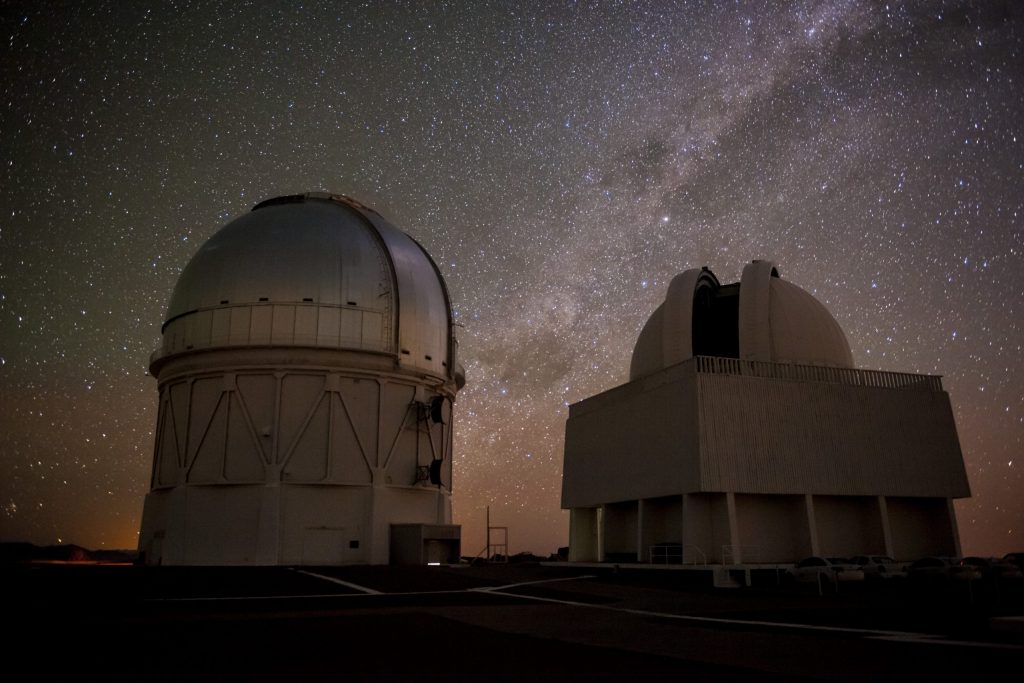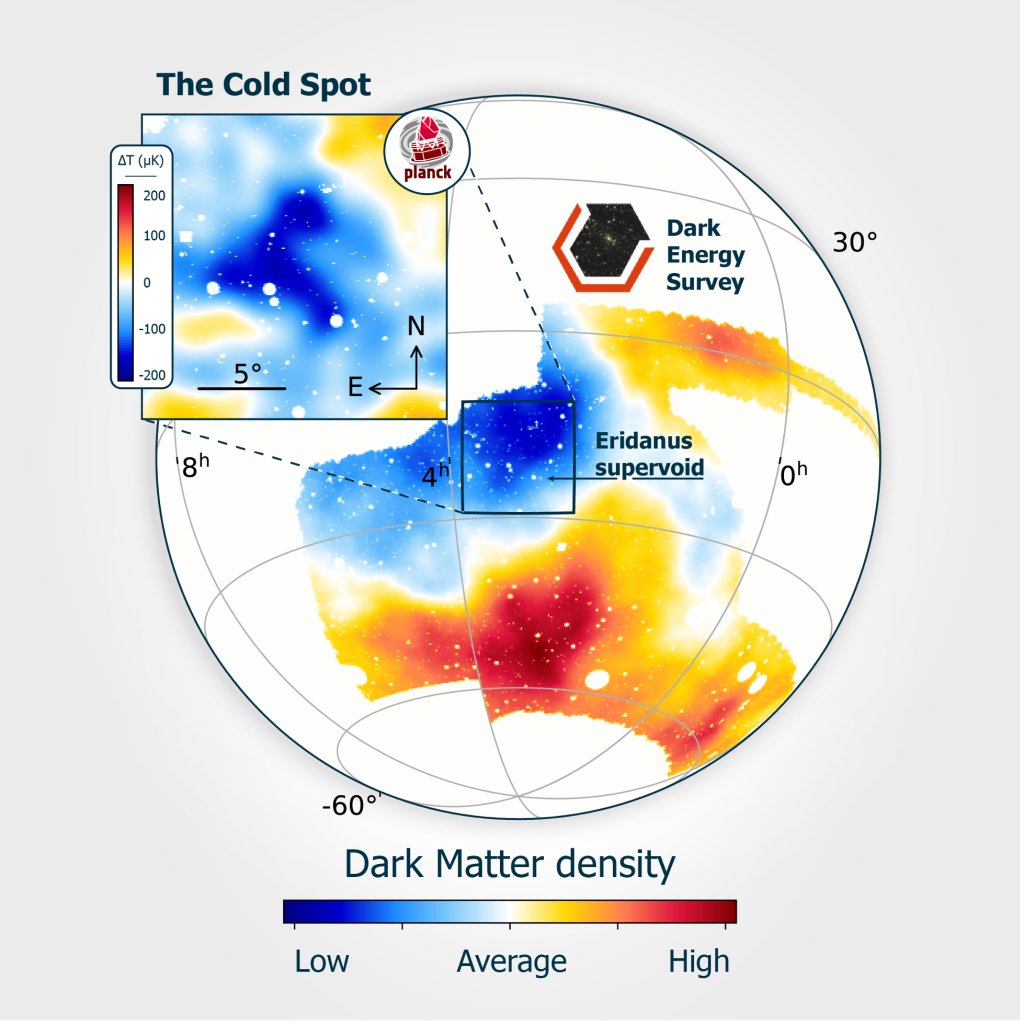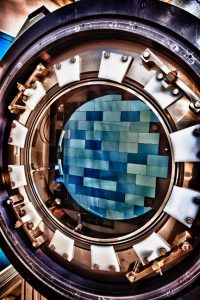After the Big Bang, the universe, glowing brightly, was opaque and so hot that atoms could not form. Eventually cooling down to about minus 454 degrees Fahrenheit (-270 degrees Celsius), much of the energy from the Big Bang took the form of light. This afterglow, known as the cosmic microwave background, can now be seen with telescopes at microwave frequencies invisible to human eyes. It has tiny fluctuations in temperature that provide information about the early universe.
Now scientists might have an explanation for the existence of an especially cold region in the afterglow, known as the CMB Cold Spot. Its origin has been a mystery so far but might be attributed to the largest absence of galaxies ever discovered.
Scientists used data collected by the Dark Energy Survey to confirm the existence of one of the largest supervoids known to humanity, the Eridanus supervoid, as reported in a paper published in December 2021. This once-hypothesized but now-confirmed void in the cosmic web might be a possible cause for the anomaly in the CMB.

Observations for the Dark Energy Survey were carried out, using the Blanco Telescope in the Andes mountains of Chile. Scientists used its data to create a map of dark matter in the region of sky that contains the Eridanus supervoid and CMB Cold Spot. Photo: Reidar Hahn, Fermilab
The Eridanus supervoid
The cosmic web is made of clusters and superclusters of galaxies. They are pulled together by the attractive force of gravity and accelerated away from each other by the repulsive force of a mysterious, not-yet-understood phenomenon called dark energy.
Between these clusters of galaxies are voids: vast regions of space that contain fewer galaxies, and thus less ordinary matter, and less dark matter than exists within the galaxy clusters.
Among the largest structures known to humanity, the supervoid in the constellation Eridanus is a massive, elongated, cigar-shaped void in the cosmic web that’s 1.8 billion lightyears wide and has been observed to contain about 30% less matter than the surrounding galactic region. Its center is located 2 billion lightyears from Earth, making it the dominant underdensity of matter in our galactic neighborhood.
Mapping dark matter
To make this discovery, scientists used Dark Energy Survey data to create a map of dark matter in the same direction as the CMB Cold Spot, by observing the effect of gravitational lensing. It’s a phenomenon that occurs when the paths of light are warped by the gravitational influence of dark matter.

The Cold Spot resides in the constellation Eridanus in the southern galactic hemisphere. The inset shows the microwave temperature map of this patch of sky, as mapped by the European Space Agency Planck satellite. The main figure depicts the map of the dark matter distribution created by the Dark Energy Survey team. Image: Gergö Kránicz and András Kovács
“This map of dark matter is the largest ever such map that’s been created,” said Niall Jeffrey, the scientist who worked on the construction of a dark matter map. “We have been able to map out dark matter over a quarter of the Southern Hemisphere.”
Scientists previously counted the number of galaxies visible in the location of the CMB Cold Spot and found an underdensity of galaxies in that region. The new map shows there is a matching underdensity of invisible dark matter.
“It is enough of a new element in the long history of the CMB Cold Spot problem that after this, people will at least be sure that there is a supervoid.” – András Kovács
Using voids to understand dark energy

The imager of the Dark Energy Camera can record tiny amounts of light from distant galaxies and supernova. Photo: Reidar Hahn, Fermilab
The Dark Energy Survey is an international effort to understand the effect dark energy has on the acceleration of the universe. It involves 300 scientists from 25 institutions in seven countries.
The Dark Energy Survey documents hundreds of millions of galaxies, supernovae and patterns within the cosmic web, using a 570-Megapixel digital camera, called the DECam, high in the Chilean Andes. This camera’s construction and integration of components was led by the U.S. Department of Energy’s Fermi National Accelerator Laboratory.
“We were thinking many years ago, a decade and a half at least, how would voids affect the present acceleration of the universe,” said Juan Garcia-Bellido, a cosmologist from IFT-Madrid and co-author of the paper.
At the largest scales of the universe, there is a tug-of-war between the gravitational forces and the expansion of the universe from dark energy, making some of the voids between galactic clusters deeper.
“Photons or particles of light enter into a void at a time before the void starts deepening and leave after the void has become deeper,” said Garcia-Bellido. “This process means that there is a net energy loss in that journey; that’s called the Integrated Sachs-Wolfe effect. When photons fall into a potential well, they gain energy, and when they come out of a potential well, they lose energy. This is the gravitational redshift effect.”
Open questions
Although the new result confirms that the Eridanus supervoid is gigantic, it still is not sufficient to explain the discrepancy between the predictions of the current standard cosmological model used to predict the behavior of dark energy—known as the Lambda Cold Dark Matter model—and the observed change in temperature in the Cold Spot that can be attributed to the supervoid’s effect on photons from the CMB.
“Having the coincidence of these two individually rare structures in the cosmic web and in the CMB is basically not enough to prove causality with the scientific standard,” said András Kovács, the lead researcher on this project.
“It is enough of a new element in the long history of the CMB Cold Spot problem that after this, people will at least be sure that there is a supervoid, which is a good thing because some people have debated that,” said Kovács.
In short, there are two ways to think about this problem: Either the Lambda-CDM model is correct, and the CMB Cold Spot is an extreme anomaly that coincidentally has a massive supervoid in front of it, or the Lambda-CDM model is incorrect, and the Integrated Sachs-Wolfe effect is stronger in supervoids than expected.
The latter would indicate a greater influence of dark energy on the universe and possibly faster cosmic expansion. Interestingly, this possibility is backed up by evidence from other, more distant supervoids. Moreover, the Dark Energy Survey team observed that the lensing signal from the Eridanus supervoid is slightly weaker than expected.
“The trouble is that typical alternative models cannot explain this discrepancy either, so if true, it might mean that we do not understand something very deep about dark energy,” said Kovács.
The Dark Energy Survey is a collaboration of more than 400 scientists from 26 institutions in seven countries. Funding for the DES Projects has been provided by the U.S. Department of Energy, the U.S. National Science Foundation, the Ministry of Science and Education of Spain, the Science and Technology Facilities Council of the United Kingdom, the Higher Education Funding Council for England, the National Center for Supercomputing Applications at the University of Illinois at Urbana-Champaign, the Kavli Institute of Cosmological Physics at the University of Chicago, Funding Authority for Studies and Projects in Brazil, Carlos Chagas Filho Foundation for Research Support of the State of Rio de Janeiro, Brazilian National Council for Scientific and Technological Development and the Ministry of Science, Technology and Innovation, the German Research Foundation and the collaborating institutions in the Dark Energy Survey, the list of which can be found at www.darkenergysurvey.org/collaboration.
Fermi National Accelerator Laboratory is supported by the Office of Science of the U.S. Department of Energy. The Office of Science is the single largest supporter of basic research in the physical sciences in the United States and is working to address some of the most pressing challenges of our time. For more information, please visit science.energy.gov.
